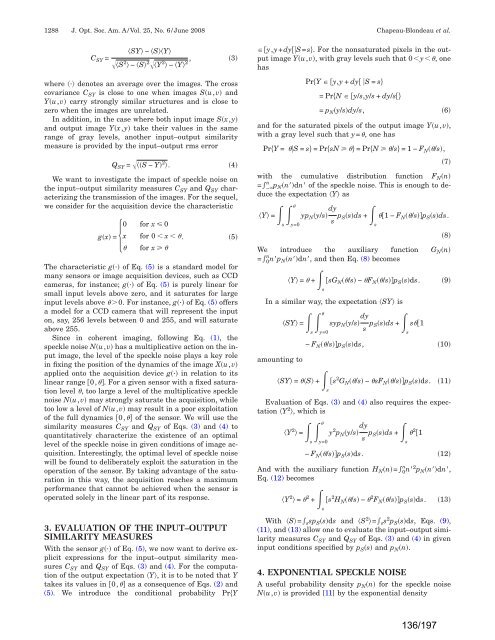a la physique de l'information - Lisa - Université d'Angers
a la physique de l'information - Lisa - Université d'Angers
a la physique de l'information - Lisa - Université d'Angers
You also want an ePaper? Increase the reach of your titles
YUMPU automatically turns print PDFs into web optimized ePapers that Google loves.
1288 J. Opt. Soc. Am. A/Vol. 25, No. 6/June 2008 Chapeau-Blon<strong>de</strong>au et al.<br />
SY − SY<br />
CSY =<br />
S2 − S2Y2 ,<br />
2 − Y<br />
3<br />
where · <strong>de</strong>notes an average over the images. The cross<br />
covariance C SY is close to one when images Su,v and<br />
Yu,v carry strongly simi<strong>la</strong>r structures and is close to<br />
zero when the images are unre<strong>la</strong>ted.<br />
In addition, in the case where both input image Sx,y<br />
and output image Yx,y take their values in the same<br />
range of gray levels, another input–output simi<strong>la</strong>rity<br />
measure is provi<strong>de</strong>d by the input–output rms error<br />
Q SY = S − Y 2 . 4<br />
We want to investigate the impact of speckle noise on<br />
the input–output simi<strong>la</strong>rity measures C SY and Q SY characterizing<br />
the transmission of the images. For the sequel,<br />
we consi<strong>de</strong>r for the acquisition <strong>de</strong>vice the characteristic<br />
=<br />
0 for x 0<br />
gx x for 0 x .<br />
5<br />
for x <br />
The characteristic g· of Eq. (5) is a standard mo<strong>de</strong>l for<br />
many sensors or image acquisition <strong>de</strong>vices, such as CCD<br />
cameras, for instance; g· of Eq. (5) is purely linear for<br />
small input levels above zero, and it saturates for <strong>la</strong>rge<br />
input levels above 0. For instance, g· of Eq. (5) offers<br />
a mo<strong>de</strong>l for a CCD camera that will represent the input<br />
on, say, 256 levels between 0 and 255, and will saturate<br />
above 255.<br />
Since in coherent imaging, following Eq. (1), the<br />
speckle noise Nu,v has a multiplicative action on the input<br />
image, the level of the speckle noise p<strong>la</strong>ys a key role<br />
in fixing the position of the dynamics of the image Xu,v<br />
applied onto the acquisition <strong>de</strong>vice g· in re<strong>la</strong>tion to its<br />
linear range 0,. For a given sensor with a fixed saturation<br />
level , too <strong>la</strong>rge a level of the multiplicative speckle<br />
noise Nu,v may strongly saturate the acquisition, while<br />
too low a level of Nu,v may result in a poor exploitation<br />
of the full dynamics 0, of the sensor. We will use the<br />
simi<strong>la</strong>rity measures C SY and Q SY of Eqs. (3) and (4) to<br />
quantitatively characterize the existence of an optimal<br />
level of the speckle noise in given conditions of image acquisition.<br />
Interestingly, the optimal level of speckle noise<br />
will be found to <strong>de</strong>liberately exploit the saturation in the<br />
operation of the sensor. By taking advantage of the saturation<br />
in this way, the acquisition reaches a maximum<br />
performance that cannot be achieved when the sensor is<br />
operated solely in the linear part of its response.<br />
3. EVALUATION OF THE INPUT–OUTPUT<br />
SIMILARITY MEASURES<br />
With the sensor g· of Eq. (5), we now want to <strong>de</strong>rive explicit<br />
expressions for the input–output simi<strong>la</strong>rity measures<br />
CSY and QSY of Eqs. (3) and (4). For the computation<br />
of the output expectation Y, it is to be noted that Y<br />
takes its values in 0, as a consequence of Eqs. (2) and<br />
(5). We introduce the conditional probability PrY<br />
y,y+dyS=s. For the nonsaturated pixels in the output<br />
image Yu,v, with gray levels such that 0y, one<br />
has<br />
PrY y,y + dyS = s<br />
=PrN y/s,y/s + dy/s<br />
= p Ny/sdy/s, 6<br />
and for the saturated pixels of the output image Yu,v,<br />
with a gray level such that y=, one has<br />
PrY = S = s =PrsN =PrN /s =1−F N/s,<br />
with the cumu<strong>la</strong>tive distribution function FNn n<br />
=−pNndn of the speckle noise. This is enough to <strong>de</strong>duce<br />
the expectation Y as<br />
<br />
Y =sy=0<br />
7<br />
ypNy/s dy<br />
s pSsds +s<br />
1−FN/spSsds. 8<br />
We introduce the auxiliary function GNn n<br />
=0npNndn, and then Eq. (8) becomes<br />
Y = +s<br />
sG N/s − F N/sp Ssds. 9<br />
In a simi<strong>la</strong>r way, the expectation SY is<br />
amounting to<br />
<br />
SY =sy=0<br />
sypNy/s dy<br />
s pSsds +s<br />
s1<br />
− F N/sp Ssds, 10<br />
SY = S +s<br />
s2GN/s − sFN/spSsds. 11<br />
Evaluation of Eqs. (3) and (4) also requires the expectation<br />
Y 2 , which is<br />
<br />
Y2 =sy=0<br />
y2pNy/s dy<br />
s pSsds +s<br />
2 1<br />
− F N/sp Ssds. 12<br />
n 2 And with the auxiliary function HNn= 0n<br />
pNndn,<br />
Eq. (12) becomes<br />
Y2 = 2 +s<br />
s2HN/s − 2FN/spSsds. 13<br />
With S= ssp Ssds and S 2 = ss 2 p Ssds, Eqs. (9),<br />
(11), and (13) allow one to evaluate the input–output simi<strong>la</strong>rity<br />
measures C SY and Q SY of Eqs. (3) and (4) in given<br />
input conditions specified by p Ss and p Nn.<br />
4. EXPONENTIAL SPECKLE NOISE<br />
A useful probability <strong>de</strong>nsity pNn for the speckle noise<br />
Nu,v is provi<strong>de</strong>d [11] by the exponential <strong>de</strong>nsity<br />
136/197


